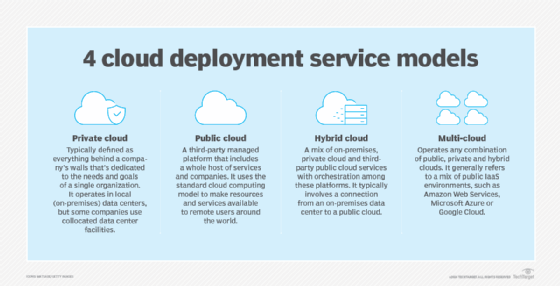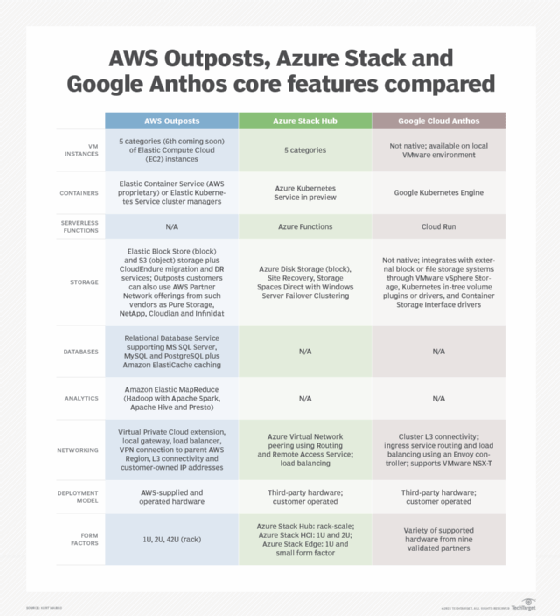What is hybrid cloud? The ultimate guide
What is a hybrid cloud?
A hybrid cloud is a cloud computing environment that uses a mix of on-premises, private cloud and third-party public cloud services with orchestration between these platforms. This typically involves a connection from an on-premises data center to a public cloud. The connection also can involve other private assets, including edge devices or other cloud services, such as storage.
The concept of hybrid cloud computing reflects the modern idea that IT resources and services are not singular or ubiquitous, but rather a complex and dynamic mix of hardware, applications, resources and services. All of those varied assets can be operated from many providers and delivered to an enterprise on demand from countless global locations.
How do hybrid clouds work?
In a hybrid cloud model, enterprises deploy workloads in private IT environments or public clouds -- including IaaS, PaaS and SaaS -- and can often move workloads and data between them as computing needs and costs change. This gives a business greater flexibility and more data deployment options. A hybrid cloud workload includes the network, hosting and web service features of an application.
For example, a typical hybrid cloud might simultaneously involve the following common components:
- Local. One or more applications deployed in a traditional local data center. These local workloads are often mission-critical where regulatory or business pressures require the enterprise to exert direct control over the local infrastructure, applications and data.
- Cloud. One or more applications and data stores deployed to a select region (data center) of a public cloud provider. These deployments often reflect less critical or less used workloads and data, as well as short-term or experimental deployments. The business manages and interacts with public clouds through the cloud providers' web portals and APIs. It is increasingly common for an enterprise to utilize more than one public cloud in order to benefit from each cloud's unique resource or service offerings.
- PaaS and SaaS. One or more applications and data stores hosted by PaaS and SaaS providers. These are often workloads the business needs but chooses not to deploy and operate in-house. Common SaaS examples include HR, accounting, finance, business intelligence and software development toolkits.
All of these elements can create a complex web of workloads and data that businesses increasingly struggle to manage cost-effectively.
While the terms are sometimes discussed interchangeably, there are key differences between hybrid and multi-cloud models. A hybrid cloud creates a single environment in which to operate on-premises private resources, public cloud resources -- such as those offered by AWS, Microsoft and Google -- and the services offered by PaaS and SaaS providers. A multi-cloud environment consists of two or more public cloud providers but does not require a private or on-premises component. For example, a business that deploys certain workloads in AWS and other workloads in Azure would be termed multi-cloud.

What are the benefits of hybrid cloud?
Hybrid cloud computing enables an enterprise to deploy its most sensitive workloads in an on-premises cloud, connect to workloads and data sources hosted by independent SaaS and PaaS providers, and host less critical resources on third-party public cloud PaaS and IaaS providers. This approach enables organizations to get the best of both private and public cloud models.
The core benefits of hybrid cloud include the following:
- Flexibility. Companies work with various types of data in disparate environments and adjust their infrastructure. A hybrid cloud setup uses traditional systems alongside the latest cloud technology without a full commitment to a single vendor. Organizations can migrate workloads to and from their traditional infrastructure and a vendor's public cloud whenever necessary.
- Cost management. With a private cloud, organizations own and operate the data center infrastructure, which requires significant capital expense and fixed costs. Alternatively, public cloud resources and services are accounted as variable and operational expenses. Hybrid cloud users can choose to run workloads in whichever environment is more secure, reliable and cost-effective.
- Agility and scalability. A hybrid cloud offers more resource options via a public cloud provider versus an organization's physical data center. This makes it easier to provision, deploy and scale resources to meet demand spikes. When demand exceeds the capacity of the local data center and private cloud, an organization can burst the application to the public cloud to access extra scale and capacity.
- Resiliency and interoperability. A business can run workloads redundantly in both private and public environments. Components of one workload can also run in both environments and interoperate, such as sharing a common data source.
- Compliance. Organizations in highly regulated industries must follow restrictions on where data can reside, and this often means they cannot move certain workloads to the public cloud. With a hybrid cloud model, organizations can keep data in a private environment while operating workloads in the cloud, or they can operate workloads in a private data center and move data to and from the public cloud as needed. This lets companies meet regulatory requirements and still benefit from the cloud's elasticity.
Other hybrid cloud advantages include consistency and support for greater standardization in IT management practices.
Hybrid cloud architecture
Establishing a hybrid cloud requires four main components:
- At least one public infrastructure as a service platform, such as Amazon Web Services, Microsoft Azure or Google Cloud Platform.
- Private computing resources, such as an on-premises data center, which typically includes some private cloud capability.
- An adequate network connection to the hybrid cloud's private and public cloud environments.
- A common software platform capable of discovering, operating and managing private and public cloud elements as a unified, highly automated, policy-driven environment.
Hybrid cloud networking
A strong network connection is critical to a successful hybrid cloud strategy. Typically, this involves a WAN or dedicated networking service for additional security. A company should consistently evaluate its connection and ensure it meets the bandwidth, latency and uptime (availability) requirements specified in any service-level agreement with a cloud provider.

Hybrid cloud integration strategy and best practices
An enterprise has no direct control over a SaaS or public cloud (IaaS) architecture. That means a business must adjust its resources, environments, policies and workflows to make them compatible with its chosen public cloud platform's resources, services and APIs. This requires implementation of suitable hardware within the data center, including servers, storage, a LAN and load balancers. For an effective hybrid arrangement, these on-premises resources and environments must be able to integrate and interoperate with public cloud services and APIs. Cloud providers often supply models and best practices that can accelerate business integration and adoption.
There are two main approaches to hybrid cloud integration: Use the cloud as the front-end application hosting point, or create a unified elastic resource pool of data center and cloud functions. The former approach basically relies on one element of the hybrid architecture -- such as the public cloud -- and uses other resources, such as the data center, for auxiliary or fallback operations. This is often easier and faster to implement but poses more limitations on flexibility. The latter approach endeavors to treat all public and private elements equally from the ground up. This creates a more flexible and ubiquitous hybrid cloud environment but can be more difficult and time-consuming to implement. Consider the following questions to determine which integration strategy is right for you:
- What are my architecture's complete hybrid integration requirements?
- What combinations of technologies address my integration requirements?
- What is the most appropriate integration style or pattern for my use cases?
- Where does it make sense to deploy my integration platform?
Hybrid cloud platforms
Hybrid cloud architecture traditionally builds a virtualization layer or hypervisor on top of on-premises resources to create and support virtual machines and, increasingly, container-based workloads. On top of this, IT teams install a private cloud software layer, such as VMware Apache CloudStack, OpenNebula or OpenStack, which delivers various cloud capabilities: self-service access to services, such as compute or database instances; automation and orchestration; resilience; and billing. This layer is integrated into services and APIs from public cloud providers.
A newer hybrid cloud architecture approach involves public cloud providers offering hybrid cloud platforms that extend public cloud services into private data centers. This means everything is based on the same software stack. These hybrid cloud platforms connect public and private resources in different ways, but they often incorporate common industry technologies, such as Kubernetes to orchestrate container-based services.
Examples of hybrid cloud platforms include AWS Outposts, Azure Stack, Azure Arc, Microsoft Azure VMware Solution, Google Anthos, Nutanix Cloud Infrastructure, Nutanix Cloud Clusters, VMware Cloud Foundation, and VMware Cloud on AWS.

Public cloud vs. private cloud
A hybrid cloud model consists of public cloud and private cloud components.
The public cloud model relies on a third-party provider for on-demand IT resources, such as virtual machines, applications and storage -- as well as services such as data analytics -- over the internet or a dedicated network. Public cloud providers host workloads and deliver cloud services to multiple organizations.
The private cloud model typically uses on-premises architecture, either in a company's local data center or a separate physical infrastructure provided by a third party, such as Azure Stack. Private clouds can also be based on virtualization software. Whatever the specific private cloud approach, organizations do not share private cloud resources with other users.
There are several tradeoffs to consider between on-premises and cloud computing:
- Payment structure. Public cloud is priced on a pay-as-you-go model, whereby organizations pay only for the capacity they use, which is typically metered and billed as a monthly fee. A business that improperly configures its workloads, however, might underutilize and overpay for public cloud services. Meanwhile, on-premises computing requires a high upfront investment and additional costs, primarily for procurement, installation and maintenance.
- Security. Private cloud users are fully responsible for securing their on-premises environments, but they also have more control of sensitive data and workloads that reside in their own data center's infrastructure and resources. Public cloud providers and users share security responsibility: The provider typically ensures security of the infrastructure itself, while users must properly secure applications and data inside the cloud. Public cloud users have access to the latest security expertise and tools but are subject to misconfigurations, breaches and other risks of hosting in a shared environment over the public internet.
- Availability. Public cloud providers offer high availability and scalability, but they are not immune from outages that cause downtime across services. Meanwhile, private clouds have their own availability risks: On-premises hardware can break down and require maintenance, and any physical environment is subject to the effects of natural disasters, such as floods or fires.
Organizations planning a hybrid approach need to consider how they will move workloads between private and public clouds. Hybrid cloud migration strategies include lift and shift, refactoring and redesign.
Hybrid cloud use cases
Before you implement the technology, review common hybrid cloud use cases to determine whether this approach fits your company's IT needs.
Digital transformation. Companies often want to modernize their IT infrastructure through public cloud adoption, but legacy applications or compliance factors can preclude a business from entirely shutting down a private data center. Hybrid cloud enables companies with mixed data and application types to migrate parts of their IT infrastructure to the cloud and retain some applications on premises. This helps the business shed some IT capital costs and burden, often enabling IT staff to focus on mission-critical tasks and spend more time innovating for the business.
Disaster recovery. A hybrid cloud helps organizations replicate on-premises workloads and back up data in the cloud. If there's a disruption in the data center, workloads fail over to the cloud environment and operate properly via on-demand cloud resources. Careful implementation is necessary to avoid hybrid cloud backup challenges, such as bandwidth consumption and management complexity -- including data synchronization and restoration headaches.
Development and testing. It's cheaper and faster to develop and test applications in the public cloud because there's no need to purchase and set up on-premises physical hardware. Software developers routinely utilize public cloud platforms and other cloud services, such as storage, to host development projects.
Data processing. A hybrid cloud gives a company the option to use powerful public cloud services to run periodic analytical queries on locally stored data. For example, big data analytics that requires significant but short-term computing resources is well-suited for a public cloud.
Highly changeable workloads. The hybrid cloud model is particularly valuable for dynamic or highly changeable workloads. For example, a transactional order-entry system that experiences significant seasonal demand spikes is a good hybrid cloud candidate.
Exploring a cloud provider. Some organizations use a hybrid approach to evaluate a potential public cloud migration. An IT team can experiment with cloud tools on a small scale and learn how to work with the cloud provider before committing to a full public cloud adoption.
What are the challenges and disadvantages of hybrid cloud?
Despite these benefits, there are hybrid cloud challenges to consider.
Compatibility. On-premises and public cloud environments work together in a hybrid cloud approach, but they are not fully compatible and not easily synchronized. For example, the back-end data center component of a hybrid cloud application cannot respond as quickly as the front-end public cloud component. This causes latency problems and other complexities.
Data handling. Improper data placement and movement in a hybrid cloud can create security and cost challenges. To secure data in transit, encrypt all traffic. Populate data in the right environment to avoid moving data across cloud environments and triggering cloud network and egress fees. Ensure that necessary workloads reside in public cloud storage to avoid unnecessary transfers and prevent spikes in charges.
Complex access management. Authentication and authorization are among the biggest hybrid cloud security challenges. Organizations must adopt centralized protocols to access data in both private and public cloud environments. Use identity and access management and single sign-on tools, and assign permissions only when necessary to concentrate hybrid cloud access management. Configuration errors, poor regulatory or compliance implementation, lack of patches and other vital software maintenance, and other oversights can all contribute to data security gaps in hybrid clouds.
Network dependence. A hybrid cloud is critically dependent on WAN access, such as internet connectivity. This places enormous demands on WAN availability, bandwidth and latency; any network disruptions or outages will effectively halt hybrid cloud operation. Businesses must implement adequate WAN resources and plan for backup WAN connectivity.
Skills gap. Hybrid cloud adoption requires users and IT staff to possess a specific set of technical skills. The expertise involved with public cloud infrastructure and services differs from that for a private data center, and the learning curve to close that skills gap can lead to human error. Businesses might need to hire additional IT staff for private cloud implementation and hybrid cloud operations.
Private cloud maintenance. A hybrid cloud's on-premises or private cloud component requires substantial investment, maintenance and expertise, as it's basically a dedicated part of the local data center. Implementation of additional software, such as databases, help desk systems and other tools, can further complicate a private cloud. Proper data planning, public cloud security tools and investment in employee training and cloud certifications can help smooth a hybrid cloud adoption.
Hybrid cloud management
Hybrid cloud architecture comprises multiple environments and types of components, and thus hybrid cloud management is a complex task. Fortunately, there are strategies and tools to help resolve the complications of hybrid management and create a streamlined approach across environments.
Implement hybrid cloud management practices to maximize control of your environments. For example, establish a cloud governance policy that defines standard processes for resource configurations, access control and other important operations. This will create a consistent, unified approach across the various components in your hybrid architecture.
Centralize control of on-premises and cloud-based resources with a hybrid cloud management tool set that provides capabilities such as cost and performance monitoring, security, reporting and analytics. There are many third-party hybrid cloud management tools to choose from; these include Apptio Cloudability, CloudBolt, Embotics, Flexera Cloud Management Platform, IBM Turbonomic, Morpheus Data, Nutanix Cloud Manager Cost Governance (formerly Beam) and Scalr. Explore and test different features within your environment to choose the hybrid cloud management tool that suits your organization's particular hybrid architecture needs.
Infrastructure-as-code tools can also help manage hybrid deployment. For example, Ansible, Chef, HashiCorp's Terraform, Puppet and Salt all provide hybrid cloud management capabilities. Adoption of containers and Kubernetes orchestration is another way to unify and seamlessly migrate the resources in a hybrid architecture.






